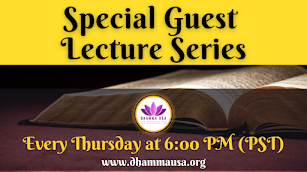Model Answer to a Question at the Mock Exam (Diploma in Buddhist Studies)
By Nivitigala Sumitta Thero (Bhante Sumitta)
For students preparing for the BUPS 13014 History of Buddhist Culture exam, we’ve provided a structured model answer discussing the Cultural Background in India in the 6th Century BC. This example highlights key socio-political, economic, and religious factors that contributed to the rise of Buddhism. The essay explores the transformation from tribal to urban societies, the emergence of powerful kingdoms like Magadha, economic growth through trade and agriculture, and the dissatisfaction with Vedic orthodoxy that led to new spiritual movements such as Buddhism and Jainism. Our team refined the model answer by incorporating historical facts, figures, and citations from scholarly sources, ensuring that it meets academic standards and provides a comprehensive understanding of the period. Visit our website to read the full essay and explore more resources for exam preparation.
Section One
Here’s an example of a structured answer to a Question: Cultural Background in India in the 6th Century BC: (Remember to make it more expansive and include facts and figures and quotes from original sources as and when necessary to make your answer more scoring.)
Question: Cultural Background in India in the 6th Century BC
Discuss the major socio-political, economic, and religious factors in India during the 6th century BC. How did these factors contribute to the emergence of Buddhism?
Introduction:
The 6th century BC in India was a period of significant cultural and religious ferment. Multiple socio-political, economic, and religious conditions contributed to the emergence of new spiritual movements, among which Buddhism was one of the most influential.
Socio-Political Context:
During this period, India witnessed the rise of powerful kingdoms and republican states, with Magadha being one of the most prominent. The shift from tribal to urban societies created new social structures that gave rise to a growing merchant class and increased economic activities. These changes led to dissatisfaction with the rigid caste system (varna), particularly among the lower classes and merchants, who sought spiritual liberation outside the orthodoxy of Brahmanism.
Economic Factors:
The development of agriculture, commerce, and trade brought about significant economic transformations. The emerging urban centers were the focal points of economic activities and facilitated interactions among diverse communities. However, wealth accumulation also heightened socio-economic inequalities, leading many to question the existing social order. Buddhism offered an alternative view on social justice, emphasizing equality and compassion for all beings, thus appealing to the masses.
Religious Factors:
The 6th century BC was a time of religious pluralism. Hinduism, dominated by Brahmanical rituals, was losing its appeal to many due to the ritualistic and sacrificial practices it promoted. Ascetic movements like Jainism and the Shramana tradition also emerged, advocating non-violence (ahimsa) and self-discipline. The Shramana movement's focus on renunciation and meditation heavily influenced early Buddhist teachings. Additionally, Buddhism’s rejection of animal sacrifices and its emphasis on moral behavior resonated with those disillusioned by Brahmanical orthodoxy.
Conclusion:
In conclusion, the socio-political instability, economic disparity, and religious dissatisfaction in India during the 6th century BC set the stage for the emergence of Buddhism. Its focus on ethical living, equality, and liberation from suffering provided a powerful alternative to the prevailing societal and religious norms, which contributed significantly to its widespread acceptance.
Section Two
A Detailed Answer:
Cultural Background in India in the 6th Century BC
Question:
Discuss the major socio-political, economic, and religious factors in India during the 6th century BC. How did these factors contribute to the emergence of Buddhism?
Introduction:
The 6th century BC in India was a period of significant cultural, religious, and political transition. Various socio-political, economic, and religious factors contributed to the rise of new spiritual movements, among which Buddhism emerged as one of the most influential. During this time, India saw the decline of Vedic orthodoxy and the rise of movements that emphasized personal spiritual liberation. Buddhism and Jainism challenged the rigid structures of society, particularly the Varna (caste) system and the emphasis on elaborate rituals, presenting alternative paths to salvation based on ethical living and non-violence.
Socio-Political Context:
The political landscape in India during the 6th century BC was dominated by powerful kingdoms and republican states, collectively known as the Mahajanapadas. Notable among these were Magadha, Kosala, and Vatsa. In these urban centers, socio-political dynamics began shifting from tribal governance towards organized monarchies and republics. For instance, Magadha, under kings like Bimbisara and Ajatashatru, became a dominant force. The rise of these centralized states contributed to an urbanizing society and a growing merchant class, which had limited mobility due to the rigid Varna system. This class sought spiritual and social freedom beyond the confines of Brahmanical orthodoxy, leading them to embrace Buddhism, which rejected the caste system.
The Republican states such as the Vrijji confederacy (later known as Vajjis), emphasized collective decision-making and governance through sanghas (assemblies), which influenced Buddhist monastic practices. The transition from rural to urban societies also led to tensions between traditional agrarian communities and the rising urban elite, setting the stage for religious and social reform movements.¹
Economic Factors:
The 6th century BC saw significant economic transformations, largely due to the rise of urban centers and increased trade activities. The establishment of cities like Rajagriha (the capital of Magadha) and Kaushambi (the capital of Vatsa) facilitated commerce and trade, particularly along the Gangetic plains and major trade routes connecting the Indian subcontinent to Central Asia. This period also saw the rise of guilds (known as Shrenis) among merchants and artisans, which contributed to the flourishing urban economy.
Agriculture continued to be a primary source of livelihood, but new agricultural practices and irrigation techniques were developed to support the growing population. The introduction of iron tools (especially in Magadha) significantly improved agricultural productivity and military capacity, further enhancing the economic and political dominance of Magadha.²
However, this prosperity also led to socio-economic inequalities. The wealth accumulation by the merchant class and landlords often left the lower castes and peasants marginalized. This increasing disparity made alternative religious movements, such as Buddhism, appealing, as they advocated for egalitarianism and emphasized compassion for all beings, irrespective of caste or status.³
Religious Factors:
The 6th century BC was a period of religious diversity and transformation. Vedic Brahmanism, with its emphasis on complex rituals, animal sacrifices, and the supremacy of Brahmins, was losing its appeal to many, particularly the merchant class and lower Varnas. The rigid ritualistic practices of Vedic religion alienated those who sought spiritual liberation beyond material offerings and sacrificial rites.
It was during this period that two significant ascetic movements arose: Jainism, founded by Mahavira, and Buddhism, founded by Gautama Buddha. Both these religions emerged from the Shramana tradition, which rejected the authority of the Vedas and emphasized individual spiritual practice through meditation and asceticism.
- Buddhism: Gautama Buddha (c. 563–483 BC) taught the Four Noble Truths and the Eightfold Path as a way to overcome suffering (Dukkha) and attain Nirvana (enlightenment). Unlike Vedic Brahmanism, Buddhism rejected the caste system and animal sacrifices and promoted ethical conduct, non-violence (Ahimsa), and meditation.⁴
- Jainism: Mahavira, a contemporary of the Buddha, also emphasized non-violence, strict ascetic practices, and the renunciation of worldly possessions. Both Jainism and Buddhism appealed to those disillusioned with the ritualistic nature of Brahmanism and offered alternative paths focused on personal liberation rather than caste-based roles in society.
The growth of these religious movements can be seen as a reaction to Brahmanical orthodoxy, which was heavily dependent on ritual purity and caste hierarchies. Buddhism, with its focus on ethical living and meditative practice, offered a more inclusive spiritual path that appealed to a broad spectrum of society, from merchants to rulers to the lower castes.⁵
Conclusion:
In conclusion, the socio-political instability, economic disparity, and religious dissatisfaction in India during the 6th century BC created fertile ground for the emergence of Buddhism. The decline of Vedic orthodoxy, combined with the rise of new urban centers and the growth of the merchant class, created a demand for a more egalitarian religious system. Buddhism’s emphasis on compassion, non-violence, and liberation from suffering provided a powerful alternative to the prevailing societal and religious norms, contributing significantly to its widespread acceptance across the Indian subcontinent.
Citations (Chicago Fullnote Style used here):
- Romila Thapar, A History of India, Volume 1 (London: Penguin Books, 1990), 42-44.
- Upinder Singh, A History of Ancient and Early Medieval India: From the Stone Age to the 12th Century (New Delhi: Pearson Education, 2008), 274-276.
- Hermann Kulke and Dietmar Rothermund, A History of India (London: Routledge, 2004), 58-61.
- Thapar, A History of India, 47-49.
- Singh, A History of Ancient and Early Medieval India, 279-281.






























0 comments:
Post a Comment
Your comments and feedback are very helpful to us in improving our posts. We really appreciate your time. Thank you!
Dhamma USA Team.